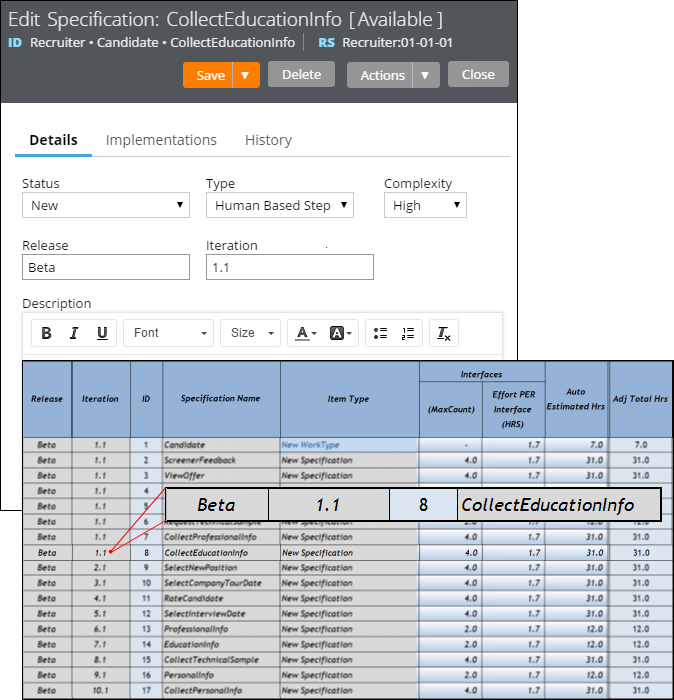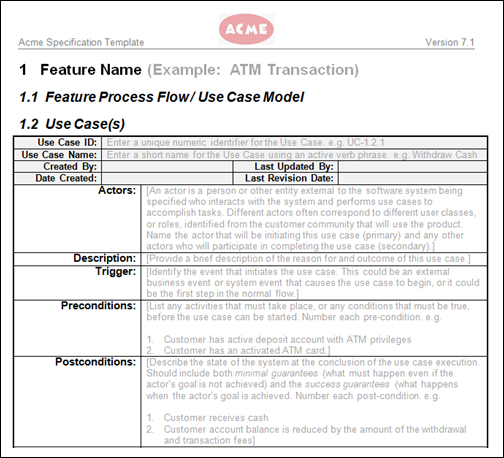Tracked changes persist between client sessions
Valid from Pega Version 7.1.7
The Microsoft Word native change tracking feature persists between client sessions for specifications. Enable this feature to facilitate collaborative reviews of your specifications with project stakeholders.
Inserting your specification updates as tracked changes allows you to:
- Provide visible markup to the next reviewer.
- Correlate edits to a specific user and time.
- Generate documents that include markup and comments.
Local settings, such as the colors you specify for markup, do not persist between clients.
For instructions on how to prevent markup and comments from appearing in generated documents, see Advanced options for editing specifications.
Add multiple attachments at once
Valid from Pega Version 7.1.7
You can now add more than one attachment to a requirement or specification at a time, without closing the Add/Edit Attachment modal dialog box. Use the traditional browse method to upload an attachment or drag and drop a local file, based on your needs. View and access your attachments from the Application Profile landing page, Requirement form, or Specification form.
Plan projects using release data
Valid from Pega Version 7.1.7
Requirements and specifications can now be mapped to a target release and iteration within a specific release. Populating these fields allows you to set and publish a release schedule through worksheets generated by the Sizing wizard. Access these fields from the Application Profile landing page or by opening any requirement or specification.

The Release and Iteration fields as they appear in a specification and a corresponding worksheet
The Sizing wizard incorporates values from the Release and Iteration fields for specifications only.
Specification type extended for decisioning users
Valid from Pega Version 7.1.7
Specifications now support a Decision Strategy Manager (DSM) type. This allows you to map your specifications to a decisioning component, such as a strategy or model. After you select an appropriate subtype and provide relevant metadata, you can run the Sizing wizard to incorporate these details into project sizing worksheets.

DSM specification details as they appear in the Specification form and Sizing wizard output
You must have access to Decision Management rulesets to create DSM specifications. For more information on specification types, refer to the Details tab of the Specification form. To view all specifications in your application, filtered by type, refer to the Application Profile landing page.
Add collections as linked implementations
Valid from Pega Version 7.1.7
You can now identify a collection or individual steps within a collection as an implementation of a specification. Linking specifications to rules allows you to more accurately convey your application design to project stakeholders. Use the Specifications tab on the Collection form to create these links.
To see all implementations for a given specification, refer to the Application Profile landing page or the Implementations tab of the Specification form.
Add project branding to generated documents
Valid from Pega Version 7.1.7
The standard Word Template for specification descriptions is now extensible. Using a customized template allows you to brand your generated documents with project-specific elements.
Specialize the Rule-Application-UseCase.pySpecificationDescription rule to:
- Include relevant images such as company logos.
- Define static text.
- Insert dynamic elements by merging clipboard values into field codes.

Generated document with custom company logo
Refer to Advanced options for editing specifications for instructions on how to override this template.
Offline mobile apps require Dynamic Container to use frameless Single Document mode
Valid from Pega Version 7.1.7
You can add a Dynamic Container (DC) directly into a Dynamic Layout cell. When creating a custom mobile app with offline capability, you must use the frameless Single Document mode of DC.
Note that mobile offline capability does not support using a framed Single Document mode.
Support for Firebase Cloud Messaging (FCM) push notifications in Android custom mobile apps
Valid from Pega Version 8.2
You can now create Android custom mobile apps that use push notifications with the Firebase Cloud Messaging (FCM) services. The push notifications for Android custom mobile apps based on legacy Google Cloud Messaging (GCM) are deprecated, as GCM services will be officially removed from use on April 11, 2019. To continue to use push notifications, you must migrate your custom mobile apps to FCM services. Before building your custom mobile app, you must register your Android app for push notifications in the Firebase console, obtain the FCM server key and Google Services JSON file, and use the key and file in the Android certificate set to build the custom mobile app.
For more information, see Migrating Android custom mobile apps that use push notifications to Firebase Cloud Messaging, Push notifications in Android mobile app, and Android certificate set.
PEGA0107 alert enables performance monitoring of offline-enabled apps
Valid from Pega Version 8.2
You can now monitor the performance of offline-enabled apps by analyzing PEGA0107 alerts from Pega Predictive Diagnostic Cloud™. PEGA0107 alerts are equivalent to PEGA0069 alerts in the context of offline-enabled applications, but PEGA0069 alerts are not generated for offline-enabled applications.
For more information, see PEGA0107 alert: Client page load time for offline-enabled applications and Pega Predictive Diagnostic Cloud Improvement Plan overview.
Mashup code preview in App Studio
Valid from Pega Version 8.2
When you create a mashup channel for your application, you can now eliminate issues with the code and create better looking applications, by using the portal preview in App Studio. You can preview a channel to verify that different types of devices correctly display the mashup code. The preview functionality uses a default wrapper that functions as a portal for displaying a frame with the mashup code. You can modify the appearance of the default wrapper, and adapt the mashup user interface in design mode to meet your requirements.
For more information, see Configuring the Mashup channel and Previewing an application.

